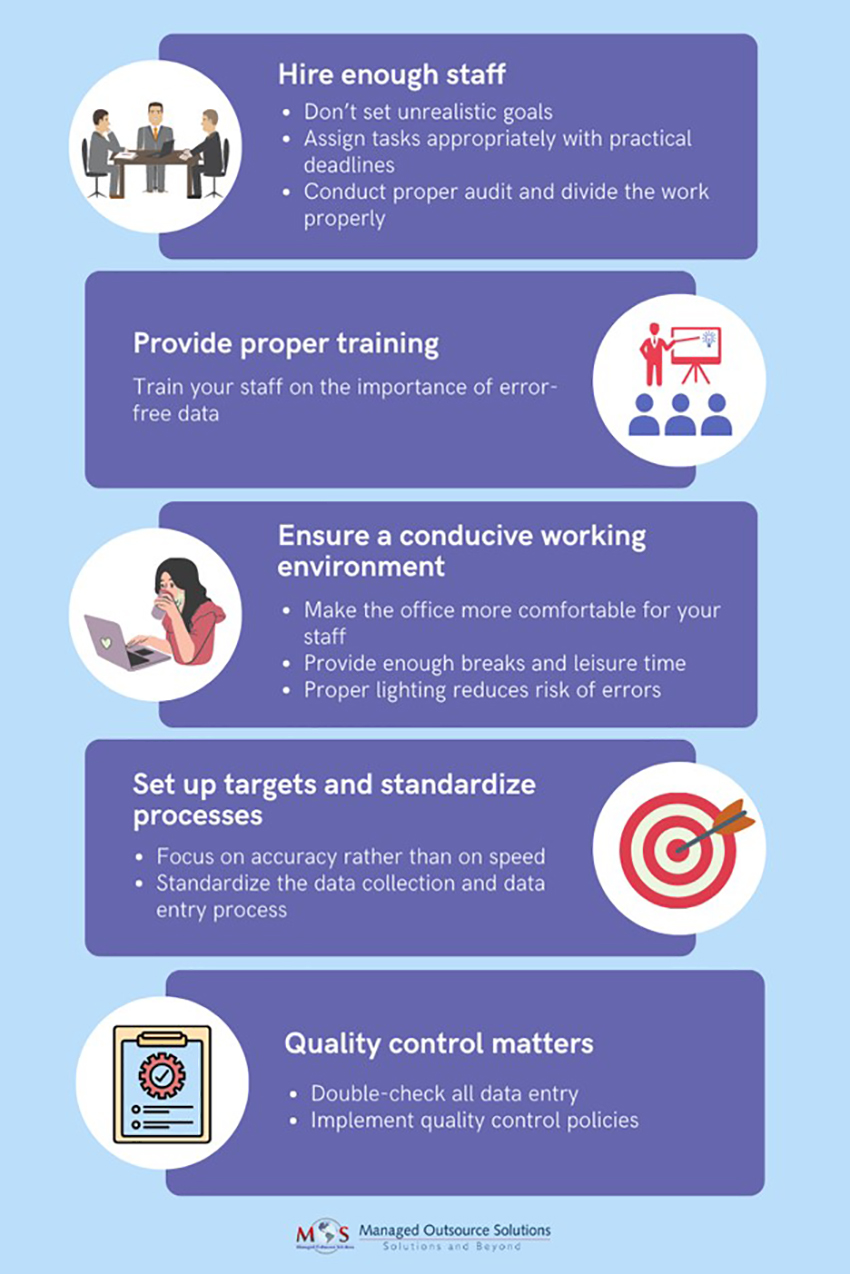Data entry plays a critical role in the digital world, supporting everything from business operations to decision-making processes. The importance of accurate, efficient data entry cannot be overstated, as it directly impacts the quality and reliability of data analysis. Most organizations choose to partner with a professional data entry company to ensure accuracy and reduce costs, as outsourcing is often more economical than hiring and managing an in-house team.
Importance of Accurate Data Entry
Inaccurate data entry, whether while taking notes or when entering information into an Excel spreadsheet, leads to loss of time, wasted resources and even lost business and lawsuits. Data inputting requires thorough attention to detail, as information comes in different formats and styles, and with confidential details.
Accurate data capture is crucial in all industries, more so in healthcare. A Pharmacy Times article published in April 2024 highlighted that accurate, complete data entry is key to medication safety. Errors when entering drug information can cause or lead to inappropriate medication use or patient harm. From patient demographic details and medical history to drug dose, directions for use, and prescriber information, error-free data entry is essential to prevent potentially disastrous consequences.
Common Data Entry Errors to Watch Out For
When it comes to manual data entry, the most common errors include the following.
- Misspelling of names or other Important Information. Example:
“John Smith” entered as “Jhon Smit”
“Sarah O’Connor” entered as “Sara OConner”
Misspelled names can lead to confusion, errors in communication, or missed records.
- Wrong Date Format While Entering Data in Excel. Example:
- Entering the date 01/12/2024 as 12/01/2024 (confusing day and month format, especially in international contexts)
- Using a text format like January 12th, 2024 instead of 01/12/2024 or 2024-01-12.
These mistakes can lead Excel to misinterpret dates, leading to errors in time-sensitive calculations.
- Data Misinterpretation. Example:
- Incorrect: Interpreting the letter “O” as the number “0”.
- Incorrect: Misunderstanding “Quantity” as “Price” and entering the wrong value. This could lead to incorrect calculations, faulty reports, or financial analysis errors.
- Missing Values. Example:
- Incorrect: Leaving a field for “Customer Phone Number” blank because the data was not available.
- Incorrect: Failing to enter a product’s “Quantity in Stock” value when updating an inventory list.
Missing data could cause problems in reporting, processing, and decision-making.
- Entering Data in the Wrong Field. Example:
- Incorrect: Entering a customer’s Phone Number in the Email Address field.
- Incorrect: Entering a Date of Birth in the Location field.
This could distort the dataset, resulting in wrong data being used for analysis, reporting, or communications.
If left unchecked, these errors can lead to incorrect analysis, delays in processes, and customer dissatisfaction. It’s important to have checks in place to catch such mistakes.
Impact of Data Entry Errors
Inaccurate or unreliable data can cost organizations millions of dollars per year, and can have a number of negative impacts on a business. According to Gartner, bad data can cost organizations $12.9 million per year. IBM estimates that businesses in the US lose $3.1 trillion annually due to poor data quality.
- Financial losses: Data errors can cause poor analysis.This can lead to financial losses from poor accounting practices, inaccurate financial reporting, and misguided investment decisions.
- Legal liabilities: Data errors can lead to legal liabilities. In regulated industries like finance and healthcare, inaccuracies can lead to compliance violations, misreporting, and potential lawsuits. These mistakes can lead fines or reputational damage.
- Compromised safety: Data errors can compromise safety. In industries like healthcare, inaccurate information can lead to incorrect treatments or medications, putting patients at risk. In manufacturing or engineering, flawed data can result in unsafe products or processes.
- Reputational damage: Data errors can damage a company’s reputation.
- Inaccurate AI models: Poor data quality affect the accuracy of AI models, which can result in unreliable predictions and diminished performance.
- Disappointing customer experiences: Inaccurate customer data can lead to disappointing customer experiences.
- Skewed business intelligence: Duplicated data can skew business intelligence. Inaccurate customer data can impact the performance of marketing campaigns.
- Compromise safety: In industries like healthcare, inaccurate information can lead to incorrect treatments or medications, putting patients at risk. In manufacturing or engineering, flawed data can result in unsafe products or processes.
Outside the business world, data errors can have significant societal repercussions. For example, a Financial Executive article highlights how a spreadsheet mistake in the U.K. led to the temporary oversight of nearly 16,000 positive COVID-19 cases, hindering contact tracing and efforts to control the virus.
Best Practice to Prevent Data Entry Errors
While it’s perfectly normal to make mistakes occasionally, there’s too much at stake when it comes to something as critical as data.
Here are some best practices to minimize/prevent data entry errors:
- Implement stringent quality checks – Double-checking the data entered helps reduce errors and eliminates the need for re-entering the data. Regular checks will also help identify areas for improvement. Data validation tools can play a key role here.
- Train employees – Make sure to train them on the importance of the data they are handling and inform them about the consequences of compromising any data. Ask them to focus more on accuracy than on speed.
- Provide enough time and allow taking breaks – Even if your operators have good data entry skills and expertise, there are always chances of mistakes when handling high volume tasks. Ensure a comfortable working environment and encourage regular breaks to help the team refresh and recharge before returning to their tasks.
- Update automated systems – If you utilize automated tools such as Intelligent Character Recognition (ICR) and Optical Character Recognition (OCR) technology for data collection or analysis, make sure to update those systems regularly. Also, protect automated systems against viruses and malware as failure to do so may result in errors.
- Batch processing: Batch processing streamlines and speeds up data input and processing by grouping similar tasks together. Employing automation tools can ensure efficient handling of repetitive tasks, and promote high accuracy and consistency by avoiding manual errors.
- Find the source of error – Check the data entry errors that occurred, statistics, and patterns to determine the primary internal and external sources of data inaccuracy. Make necessary changes to improve the processes.
Ways to Eliminate Data Entry Errors
Consider Outsourcing
Outsourcing data entry to an experienced data entry company can ensure data accuracy, along with reduced operational costs, effective data management and secure processing.
Business process outsourcing services use the latest advanced software and have experienced data entry professionals with a range of skills that allows them to complete the task efficiently. Their key competencies include strong typing skills and attention to detail to ensure data inputting accuracy. They also have proficiency in various software applications, such as spreadsheets and databases, enabling them to manage and organize information efficiently. Additionally, they can manage large volumes of data efficiently and meet client deadlines.
Transform your data entry operations by outsourcing to our expert team!
Ensure accuracy and save 20-40% on your costs!





